简单句-并列句和复合句用法及习题
- 格式:docx
- 大小:71.71 KB
- 文档页数:27
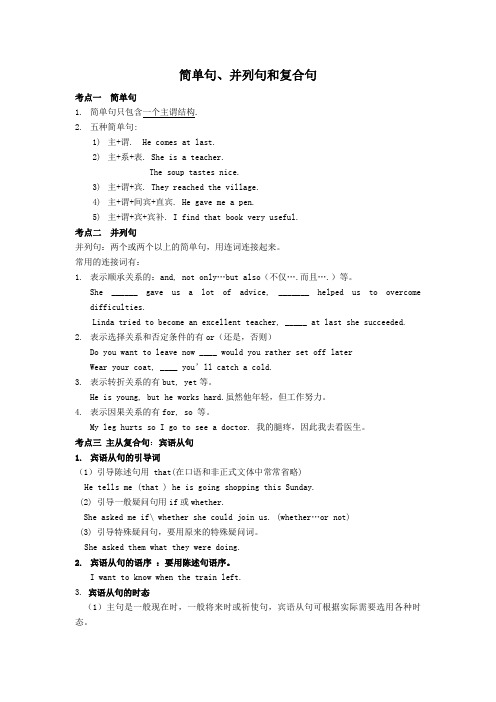
简单句、并列句和复合句考点一简单句1.简单句只包含一个主谓结构.2.五种简单句:1)主+谓. He comes at last.2)主+系+表. She is a teacher.The soup tastes nice.3)主+谓+宾. They reached the village.4)主+谓+间宾+直宾. He gave me a pen.5)主+谓+宾+宾补. I find that book very useful.考点二并列句并列句:两个或两个以上的简单句,用连词连接起来。
常用的连接词有:1.表示顺承关系的:and, not only…but also(不仅….而且….)等。
She ______ gave us a lot of advice, _______ helped us to overcome difficulties.Linda tried to become an excellent teacher, _____ at last she succeeded.2.表示选择关系和否定条件的有or(还是,否则)Do you want to leave now ____ would you rather set off laterWear your coat, ____ you’ll catch a cold.3.表示转折关系的有but, yet等。
He is young, but he works hard.虽然他年轻,但工作努力。
4.表示因果关系的有for, so 等。
My leg hurts so I go to see a doctor. 我的腿疼,因此我去看医生。
考点三主从复合句:宾语从句1.宾语从句的引导词(1)引导陈述句用 that(在口语和非正式文体中常常省略)He tells me (that ) he is going shopping this Sunday.(2) 引导一般疑问句用if或whether.She asked me if\ whether she could join us. (whether…or not)(3) 引导特殊疑问句,要用原来的特殊疑问词。
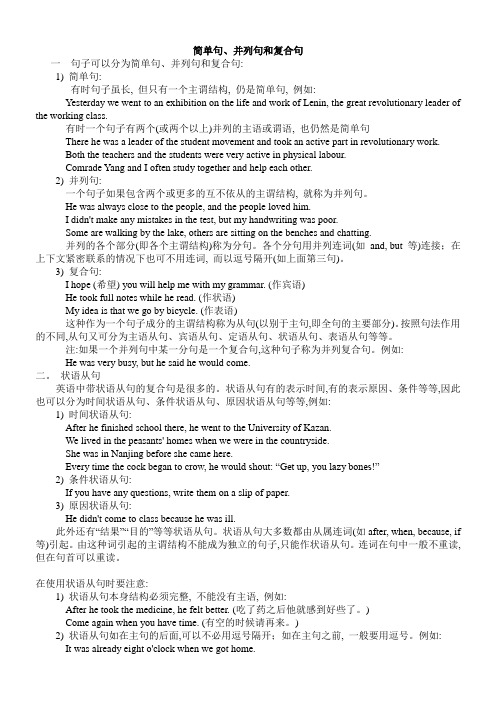
简单句、并列句和复合句一句子可以分为简单句、并列句和复合句:1) 简单句:有时句子虽长, 但只有一个主谓结构, 仍是简单句, 例如:Yesterday we went to an exhibition on the life and work of Lenin, the great revolutionary leader of the working class.有时一个句子有两个(或两个以上)并列的主语或谓语, 也仍然是简单句There he was a leader of the student movement and took an active part in revolutionary work.Both the teachers and the students were very active in physical labour.Comrade Yang and I often study together and help each other.2) 并列句:一个句子如果包含两个或更多的互不依从的主谓结构, 就称为并列句。
He was always close to the people, and the people loved him.I didn't make any mistakes in the test, but my handwriting was poor.Some are walking by the lake, others are sitting on the benches and chatting.并列的各个部分(即各个主谓结构)称为分句。
各个分句用并列连词(如and, but 等)连接;在上下文紧密联系的情况下也可不用连词, 而以逗号隔开(如上面第三句)。
3) 复合句:I hope (希望) you will help me with my grammar. (作宾语)He took full notes while he read. (作状语)My idea is that we go by bicycle. (作表语)这种作为一个句子成分的主谓结构称为从句(以别于主句,即全句的主要部分)。
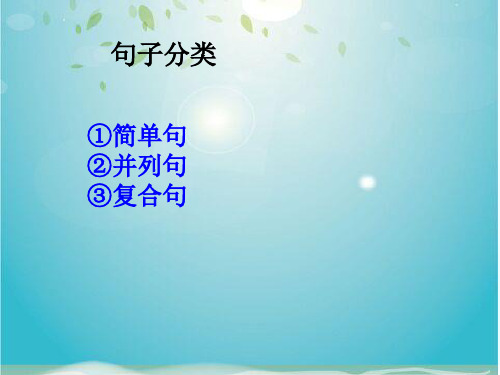

并列句和复合句句子按结构可分为简单句、并列句和复合句。
考点1.并列句由并列连词(and, but, or等)或分号(;)把两个或两个以上的简单句连在一起构成。
要注意哟,逗号是不可以连接句子的,这一点和汉语不同。
e.g.You help him and he helps you. The future is bright; the road is tortuous. 前途是光明的,道路是曲折的。
①表示连接两个同等概念,常用and, not only…but also…, neither…nor…, then等连接。
and所连接的前后分句往往表示先后关系、递进关系。
前后分句的时态往往保持一致关系,若第一个分句是祈使句,那么第二个分句用将来时。
The teacher’s name is Smith, and the student’s name is John.He not only stole my money, but he also took my watch away.②表示选择,常用的连词有or, either…or…, otherwise等。
前后分句的时态往往保持一致关系,若第一个分句是祈使句,那么第二个分句用将来时。
Hurry up, or you’ll miss the train.③表示转折,表明两个概念彼此有矛盾、相反或者转折,常用的连词有but, still, however, yet, while,when等前后分句时态一致。
He was a little man with thick glasses, but he had a strange way of making his classes lively and interesting.④表示因果关系,常用的连词有so, for, therefore等。
前后分句时态一致。
August is the time of the year for rice harvest, so every day I work from dawn until dark.考点2.复合句复合句含有两个或两个以上主谓结构,其中一个主谓结构作另一个的成分。
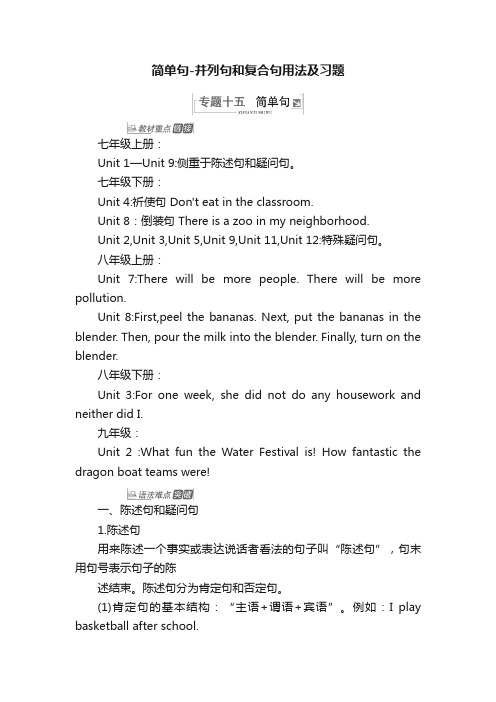
简单句-并列句和复合句用法及习题七年级上册:Unit 1—Unit 9:侧重于陈述句和疑问句。
七年级下册:Unit 4:祈使句 Don't eat in the classroom.Unit 8:倒装句 There is a zoo in my neighborhood.Unit 2,Unit 3,Unit 5,Unit 9,Unit 11,Unit 12:特殊疑问句。
八年级上册:Unit 7:There will be more people. There will be more pollution.Unit 8:First,peel the bananas. Next, put the bananas in the blender. Then, pour the milk into the blender. Finally, turn on the blender.八年级下册:Unit 3:For one week, she did not do any housework and neither did I.九年级:Unit 2 :What fun the Water Festival is! How fantastic the dragon boat teams were!一、陈述句和疑问句1.陈述句用来陈述一个事实或表达说话者看法的句子叫“陈述句”,句末用句号表示句子的陈述结束。
陈述句分为肯定句和否定句。
(1)肯定句的基本结构:“主语+谓语+宾语”。
例如:I play basketball after school.(2)否定句又分为完全否定和部分否定。
①完全否定词有not,no,no one,nobody,nothing,neither,none,never。
例如:None of us have been to Canada.②部分否定词有hardly,seldom,few,little以及not与both,all,each,every,quite,always等连用所表示的部分否定。
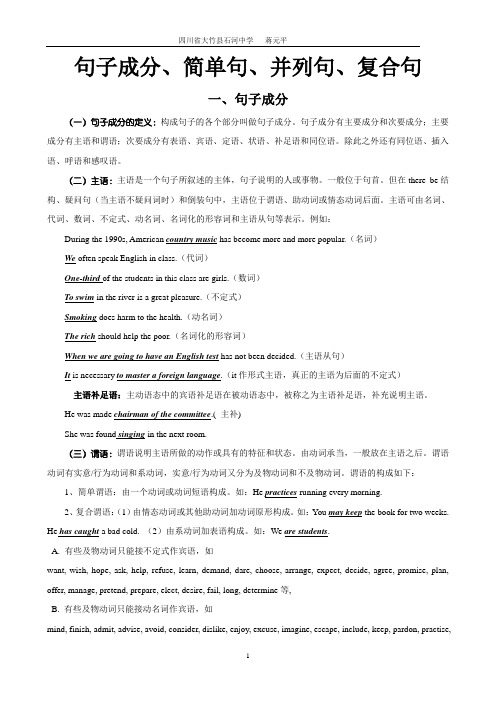
句子成分、简单句、并列句、复合句一、句子成分(一)句子成分的定义:构成句子的各个部分叫做句子成分。
句子成分有主要成分和次要成分;主要成分有主语和谓语;次要成分有表语、宾语、定语、状语、补足语和同位语。
除此之外还有同位语、插入语、呼语和感叹语。
(二)主语:主语是一个句子所叙述的主体,句子说明的人或事物。
一般位于句首。
但在there be结构、疑问句(当主语不疑问词时)和倒装句中,主语位于谓语、助动词或情态动词后面。
主语可由名词、代词、数词、不定式、动名词、名词化的形容词和主语从句等表示。
例如:During the 1990s, American country music has become more and more popular.(名词)We often speak English in class.(代词)One-third of the students in this class are girls.(数词)To swim in the river is a great pleasure.(不定式)Smoking does harm to the health.(动名词)The rich should help the poor.(名词化的形容词)When we are going to have an English test has not been decided.(主语从句)It is necessary to master a foreign language.(it作形式主语,真正的主语为后面的不定式)主语补足语:主动语态中的宾语补足语在被动语态中,被称之为主语补足语,补充说明主语。
He was made chairman of the committee.( 主补)She was found singing in the next room.(三)谓语:谓语说明主语所做的动作或具有的特征和状态。
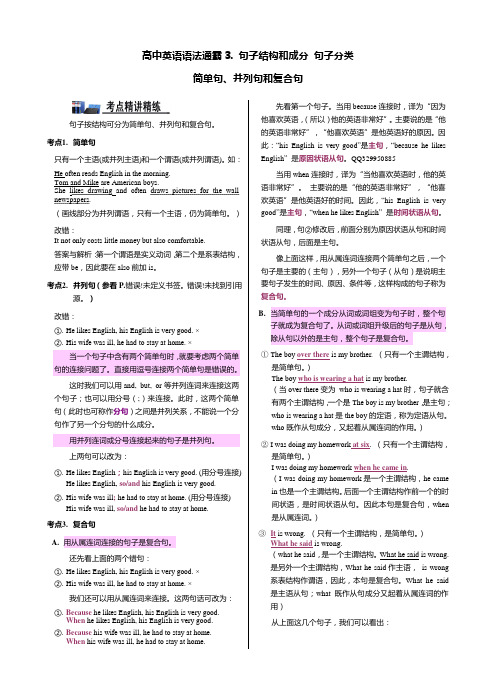
高中英语语法通霸3. 句子结构和成分句子分类简单句、并列句和复合句句子按结构可分为简单句、并列句和复合句。
考点1.简单句只有一个主语(或并列主语)和一个谓语(或并列谓语)。
如:He often reads English in the morning.Tom and Mike are American boys.She likes drawing and often draws pictures for the wall newspapers.(画线部分为并列谓语,只有一个主语,仍为简单句。
)改错:It not only costs little money but also comfortable.答案与解析:第一个谓语是实义动词,第二个是系表结构,应带be,因此要在also前加is。
考点2.并列句(参看P.错误!未定义书签。
错误!未找到引用源。
)改错:①.He likes English, his English is very good. ×②.His wife was ill, he had to stay at home. ×当一个句子中含有两个简单句时,就要考虑两个简单句的连接问题了。
直接用逗号连接两个简单句是错误的。
这时我们可以用and, but, or等并列连词来连接这两个句子;也可以用分号(;)来连接。
此时,这两个简单句(此时也可称作分句)之间是并列关系,不能说一个分句作了另一个分句的什么成分。
用并列连词或分号连接起来的句子是并列句。
上两句可以改为:①.He likes English;his English is very good. (用分号连接)He likes English, so/and his English is very good.②.His wife was ill; he had to stay at home. (用分号连接)His wife was ill, so/and he had to stay at home.考点3.复合句A.用从属连词连接的句子是复合句。

简单句、并列句和复合句参考答案一、1、简单句;2、复合句;3、简单句;4、简单句;5、并列句;6、复合句;7、并列句;8、复合句;9、简单句;10、简单句二、I hope you are very well(复合句). I'm fine, but tired(简单句). Right now it is the summer vacation and I'm helping my Dad on the farm(并列句). August is the hottest month here(简单句). It is the time of year for the rice harvest, so every day I work from dawn until dark.(并列句)Sometimes we go on working after dark by the lights of our tractors(简单句). We grow rice in the south of the States, but in the north where it is colder they grow wheat(并列复合句). We have a lot of machines on the farm(简单句). Although the farm is large, my Dad has only two men working for him(复合句). But he employs more men for the harvest(简单句). My brother takes care of the vegetable garden(简单句). It doesn't often rain in the summer here (简单句). As a result, we have to water the vegetable garden(简单句). Every evening we pump water from a well(简单句). It then runs along channels to different parts of the garden(简单句).Most Saturday evenings there is a party, even at harvest time(简单句). These parties often make us very happy(简单句). We cook meat on an open fire outside (简单句). It's great(简单句)! Americans eat a lot of meat — too much in my opinion (简单句). Some of my friends drink beer(简单句). I don't, because I have to drive home after the party(复合句). In your letter you asked about the time in different areas of the States(简单句). There are five different time areas in the States(简单句). In my state we are fourteen hours behind Beijing time(简单句). How many different time areas do you have in China(简单句)? Well, I must stop and get some sleep(简单句). Please give my best regards to your parents(简单句).三、1~5 ACADD 6~10 BCBDC 11~15 ADBCC 16~20 ABADB 21~25 DDDCD26~30 ADDBD四、1. He doesn’t dare to tell the truth. 或He dare not tell the truth. 2. How long have they lived here? 3. won’t there 4. Be careful with your pronunciation.5. Did they go for a walk after supper yesterday evening?6. What an interesting story (it is)! 或How interesting the story is!7. How often does this magazine come out?8. could they9. How brightly the moon is shining!10. Who is always encouraging us to speak English in class?。
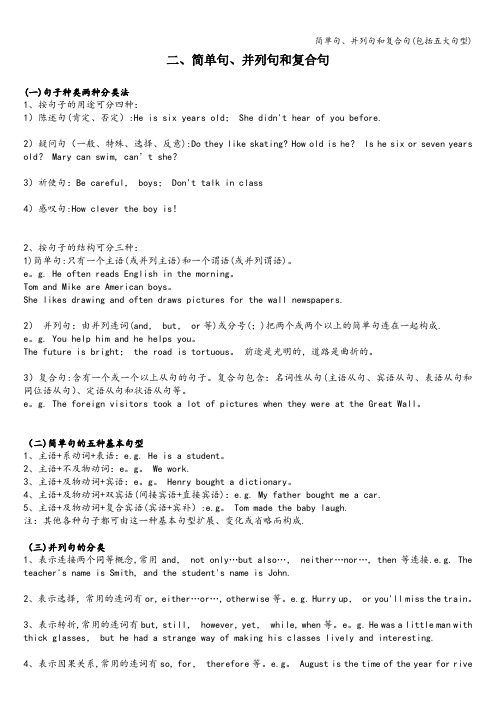
二、简单句、并列句和复合句(一)句子种类两种分类法1、按句子的用途可分四种:1)陈述句(肯定、否定):He is six years old; She didn't hear of you before.2)疑问句(一般、特殊、选择、反意):Do they like skating? How old is he? Is he six or seven years old? Mary can swim, can’t she?3)祈使句:Be careful, boys; Don't talk in class4)感叹句:How clever the boy is!2、按句子的结构可分三种:1)简单句:只有一个主语(或并列主语)和一个谓语(或并列谓语)。
e。
g. He often reads English in the morning。
Tom and Mike are American boys。
She likes drawing and often draws pictures for the wall newspapers.2)并列句:由并列连词(and, but, or等)或分号(;)把两个或两个以上的简单句连在一起构成.e。
g. You help him and he helps you。
The future is bright; the road is tortuous。
前途是光明的,道路是曲折的。
3)复合句:含有一个或一个以上从句的句子。
复合句包含:名词性从句(主语从句、宾语从句、表语从句和同位语从句)、定语从句和状语从句等。
e。
g. The foreign visitors took a lot of pictures when they were at the Great Wall。
(二)简单句的五种基本句型1、主语+系动词+表语:e.g. He is a student。
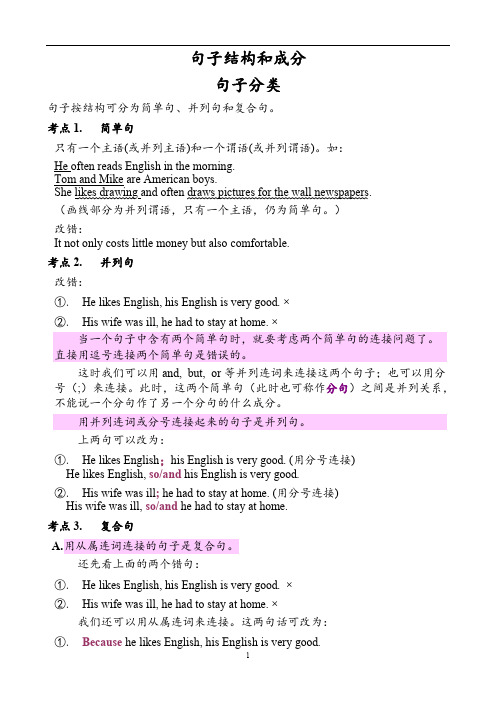
句子结构和成分句子分类句子按结构可分为简单句、并列句和复合句。
考点1.简单句只有一个主语(或并列主语)和一个谓语(或并列谓语)。
如:He often reads English in the morning.Tom and Mike are American boys.She likes drawing and often draws pictures for the wall newspapers.(画线部分为并列谓语,只有一个主语,仍为简单句。
)改错:It not only costs little money but also comfortable.考点2.并列句改错:①.He likes English, his English is very good. ×②.His wife was ill, he had to stay at home. ×当一个句子中含有两个简单句时,就要考虑两个简单句的连接问题了。
直接用逗号连接两个简单句是错误的。
这时我们可以用and, but, or等并列连词来连接这两个句子;也可以用分号(;)来连接。
此时,这两个简单句(此时也可称作分句)之间是并列关系,不能说一个分句作了另一个分句的什么成分。
用并列连词或分号连接起来的句子是并列句。
上两句可以改为:①.He likes English;his English is very good. (用分号连接)He likes English, so/and his English is very good.②.His wife was ill; he had to stay at home. (用分号连接)His wife was ill, so/and he had to stay at home.考点3.复合句A.用从属连词连接的句子是复合句。
还先看上面的两个错句:①.He likes English, his English is very good.×②.His wife was ill, he had to stay at home. ×我们还可以用从属连词来连接。
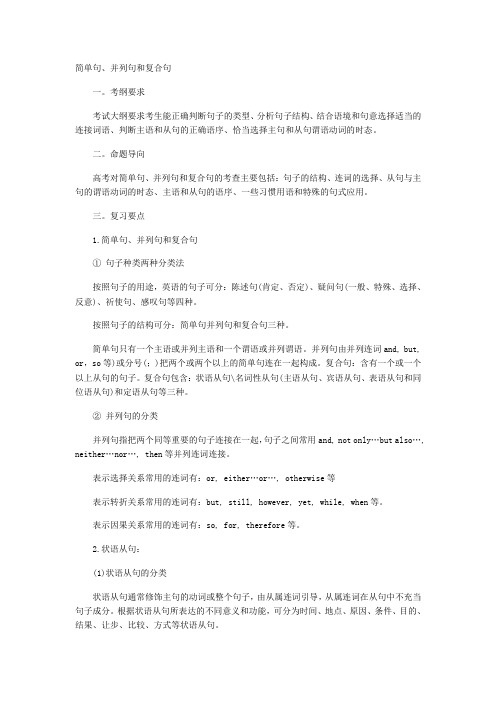
简单句、并列句和复合句一。
考纲要求考试大纲要求考生能正确判断句子的类型、分析句子结构、结合语境和句意选择适当的连接词语、判断主语和从句的正确语序、恰当选择主句和从句谓语动词的时态。
二。
命题导向高考对简单句、并列句和复合句的考查主要包括:句子的结构、连词的选择、从句与主句的谓语动词的时态、主语和从句的语序、一些习惯用语和特殊的句式应用。
三。
复习要点1.简单句、并列句和复合句① 句子种类两种分类法按照句子的用途,英语的句子可分:陈述句(肯定、否定)、疑问句(一般、特殊、选择、反意)、祈使句、感叹句等四种。
按照句子的结构可分:简单句并列句和复合句三种。
简单句只有一个主语或并列主语和一个谓语或并列谓语。
并列句由并列连词and, but, or,so等)或分号(;)把两个或两个以上的简单句连在一起构成。
复合句:含有一个或一个以上从句的句子。
复合句包含:状语从句\名词性从句(主语从句、宾语从句、表语从句和同位语从句)和定语从句等三种。
② 并列句的分类并列句指把两个同等重要的句子连接在一起,句子之间常用and, not only…but also…, neither…nor…, then等并列连词连接。
表示选择关系常用的连词有:or, either…or…, otherwise等表示转折关系常用的连词有:but, still, however, yet, while, when等。
表示因果关系常用的连词有:so, for, therefore等。
2.状语从句:(1)状语从句的分类状语从句通常修饰主句的动词或整个句子,由从属连词引导,从属连词在从句中不充当句子成分。
根据状语从句所表达的不同意义和功能,可分为时间、地点、原因、条件、目的、结果、让步、比较、方式等状语从句。
(2)连接状语从句的词语时间状语从句:when, whenever每当……,after, before, as, as soon as, hardly/ scarcely...when..., no sooner...than.。
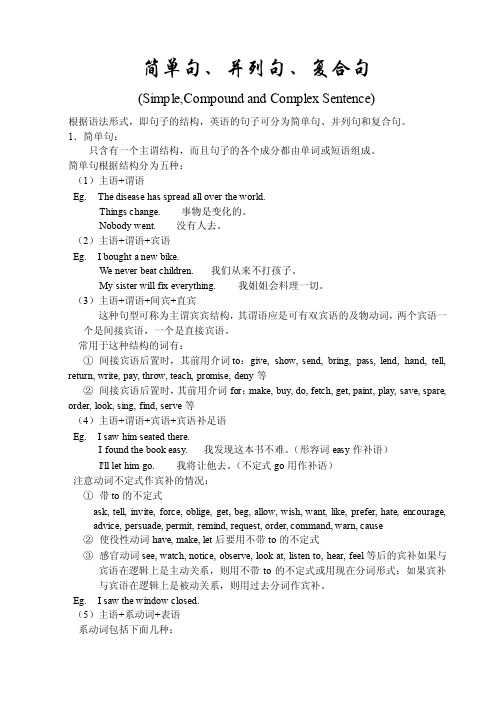
简单句、并列句、复合句(Simple,Compound and Complex Sentence)根据语法形式,即句子的结构,英语的句子可分为简单句、并列句和复合句。
1.简单句:只含有一个主谓结构,而且句子的各个成分都由单词或短语组成。
简单句根据结构分为五种:(1)主语+谓语Eg. The disease has spread all over the world.Things change. 事物是变化的。
Nobody went. 没有人去。
(2)主语+谓语+宾语Eg. I bought a new bike.We never beat children. 我们从来不打孩子。
My sister will fix everything. 我姐姐会料理一切。
(3)主语+谓语+间宾+直宾这种句型可称为主谓宾宾结构,其谓语应是可有双宾语的及物动词,两个宾语一个是间接宾语,一个是直接宾语。
常用于这种结构的词有:①间接宾语后置时,其前用介词to:give, show, send, bring, pass, lend, hand, tell, return, write, pay, throw, teach, promise, deny等②间接宾语后置时,其前用介词for:make, buy, do, fetch, get, paint, play, save, spare, order, look, sing, find, serve等(4)主语+谓语+宾语+宾语补足语Eg. I saw him seated there.I found the book easy. 我发现这本书不难。
(形容词easy作补语)I'll let him go. 我将让他去。
(不定式go用作补语)注意动词不定式作宾补的情况:①带to的不定式ask, tell, invite, force, oblige, get, beg, allow, wish, want, like, prefer, hate, encourage, advice, persuade, permit, remind, request, order, command, warn, cause②使役性动词have, make, let后要用不带to的不定式③感官动词see, watch, notice, observe, look at, listen to, hear, feel等后的宾补如果与宾语在逻辑上是主动关系,则用不带to的不定式或用现在分词形式;如果宾补与宾语在逻辑上是被动关系,则用过去分词作宾补。
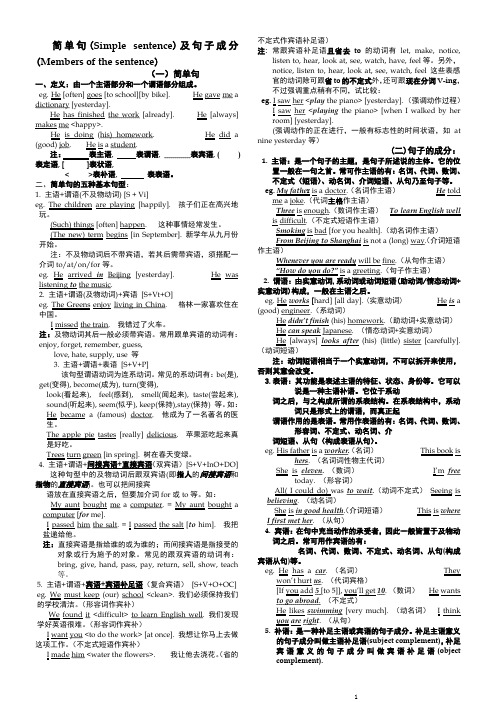
简单句(Simple sentence)及句子成分(Members of the sentence)(一)简单句一、定义:由一个主语部分和一个谓语部分组成。
eg. He [often] goes [to school][by bike]. He gave me a dictionary [yesterday].He has finished the work [already]. He [always] makes me <happy>.He is doing (his) homework. He did a (good) job. He is a student.注:表主语, 表谓语, 表宾语, ( )表定语, [ ]表状语,< >表补语, 表表语。
二、简单句的五种基本句型:1. 主语+谓语(不及物动词) [S + Vi]eg. The children are playing [happily]. 孩子们正在高兴地玩。
(Such) things [often] happen. 这种事情经常发生。
(The new) term begins [in September]. 新学年从九月份开始。
注:不及物动词后不带宾语,若其后需带宾语,须搭配一介词to/at/on/for等。
eg. He arrived in Beijing [yesterday]. He was listening to the music.2. 主语+谓语(及物动词)+宾语[S+Vt+O]eg. The Greens enjoy living in China. 格林一家喜欢住在中国。
I missed the train. 我错过了火车。
注:及物动词其后一般必须带宾语。
常用跟单宾语的动词有:enjoy, forget, remember, guess,love, hate, supply, use 等3. 主语+谓语+表语[S+V+P]该句型谓语动词为连系动词。
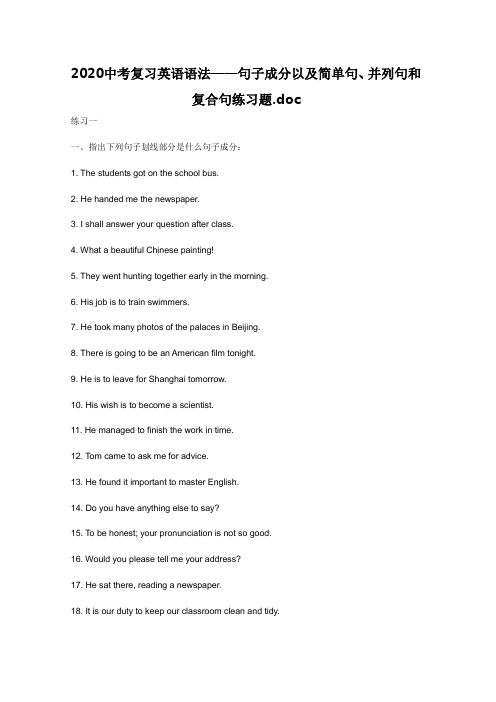
2020中考复习英语语法——句子成分以及简单句、并列句和复合句练习题.doc练习一一、指出下列句子划线部分是什么句子成分:1. The students got on the school bus.2. He handed me the newspaper.3. I shall answer your question after class.4. What a beautiful Chinese painting!5. They went hunting together early in the morning.6. His job is to train swimmers.7. He took many photos of the palaces in Beijing.8. There is going to be an American film tonight.9. He is to leave for Shanghai tomorrow.10. His wish is to become a scientist.11. He managed to finish the work in time.12. Tom came to ask me for advice.13. He found it important to master English.14. Do you have anything else to say?15. To be honest; your pronunciation is not so good.16. Would you please tell me your address?17. He sat there, reading a newspaper.18. It is our duty to keep our classroom clean and tidy.19. He noticed a man enter the room.20. The apples tasted sweet.二、用符号划出下列短文各句中的主语(—)、谓语(=)、宾语(~):I hope you are very well. I'm fine, but tired. Right now it is the summer vacation and I'm helping my Dad on the farm. August is the hottest month here. It is the time of year for the rice harvest, so every day I work from dawn until dark. Sometimes we go on working after dark by the lights of our tractors. We grow rice in the south of the States, but in the north where it is colder they grow wheat. We have a lot of machines on the farm. Although the farm is large, my Dad has only two men working for him. But he employs more men for the harvest. My brother takes care of the vegetable garden. It doesn't often rain in the summer here. As a result, we have to water the vegetable garden. Every evening we pump water from a well. It then runs along channels to different parts of the garden.三、用符号划出下列短文各句中的定语(—)、状语(=)、补语(~):Most Saturday evenings there is a party, even at harvest time. These parties often make us very happy. We cook meat on an open fire outside. It's great! Americans eat a lot of meat —too much in my opinion. Some of my friends drink beer. I don't, because I have to drive home after the party. In your letter you asked about the time in different areas of the States. There are five different time areas in the States. In my state we are fourteen hours behind Beijing time. How many different time areas do you have in China? Well, I must stop and get some sleep. Please give my best regards to your parents.四、选择填空:( )1. ____ will leave for Beijing.A. Now there the manB. The man here nowC. The man who is here nowD. The man is here now( ) 2. The weather ____.A. wet and coldB. is wet and coldC. not wet and coldD. were wet and cold( ) 3. The apple tasted ____.A. sweetsB. sweetlyC. nicelyD. sweet( ) 4. He got up ____ yesterday morning.A. latelyB. lateC. latestD. latter( )5. The actor ______at the age of 70.A. deadB. diedC. dyedD. deaded( )6. ____ were all very tired, but none of ____ would stop to take a rest.A. We, usB. Us, weC. We, ourD. We, we( )7. He found the street much ______.A. crowdB. crowdingC. crowdedD. crowdedly( ) 8.I think _____necessary to learn English well.A. itsB. itC. thatD. that is( ) 9. The dog ____ mad.A. looksB. is lookedC. is being lookedD. was looked( )10.I will never forget the day ______ I joined the army.A. thatB. whenC. in whichD. where练习二、简单句、并列句和复合句一、判断下列句子是简单句、并列句还是复合句:1. We often study Chinese history on Friday afternoon.2. The boy who offered me his seat is called Tom.3. There is a chair in this room, isn’t there?4. My brother and I go to school at half past seven in the morning and come back home at seven in the evening.5. He is in Class One and I am in Class Two.6. He was fond of drawing when he was yet a child.7. Neither has he changed his mind, nor will he do so.8. What he said at the meeting is very important, isn’t it?9. The farmer is showing the boy how to plant a tree.10. Both Tom and Jack enjoy country music.二、判断下列短文中各句是简单句、并列句还是复合句:I hope you are very well( ). I'm fine, but tired( ). Right now it is the summer vacation and I'm helping my Dad on the farm( ). August is the hottest month here( ). It is the time of year for the rice harvest, so every day I work from dawn until dark.( ) Sometimes we go on working after dark by the lights of our tractors( ). We grow rice in the south of the States, but in the north where it is colder they grow wheat( ). We have a lot of machines on the farm( ). Although the farm is large, my Dad has only two men working for him( ). But he employs more men for the harvest( ). My brother takes care of the vegetable garden( ). It doesn't often rain in the summer here( ). As a result, we have to water the vegetable garden( ). Every evening we pump water from a well( ). It then runs along channels to different parts of the garden( ).Most Saturday evenings there is a party, even at harvest time( ). These parties often make us very happy( ). We cook meat on an open fire outside( ). It's great( )! Americans eat a lot of meat — too much in my opinion( ). Some of my friends drink beer( ). I don't, because I have to drive home after the party( ). In your letter you asked about the time in different areas of the States( ). There are five different time areas in the States( ). In my state we are fourteen hours behind Beijing time( ). How many different time areas do you have in China( )? Well, I must stop and get some sleep( ). Please give my best regards to your parents( ).三、选择填空:1. Give me one more minute ____ I’ll be able to finish it.A. andB. orC. ifD. so2. It’s the third time that John has been late, ____?A. hasn’t heB. isn’t heC. isn’t itD. hasn’t it3. ____ joyful he was to meet his brother again!A. HowB. WhatC. What aD. What an4. Let us pass, ____?A. shan’t weB. shall weC. won’t weD. will you5. I suppose he’s serious, ____ ?A. do IB. don’t IC. is heD. isn’t he6. You had better not smoke here, ____?A. will youB. had youC. shall youD. have you7. Train as hard as you can ____ you’ll win the swimming competition.A. thenB. butC. andD. or8. I’m sorry to have to say this, ____ you forgot to turn off the lights when you left the room last night.A. andB. butC. soD. because9. John has not yet passed the driving test, and ____.A. Henry hasn’t tooB. Henry also has not eitherC. neither Henry hasD. neither has Henry10. There are many sports lovers in his office. Some love climbing, ____ others enjoy swimming.A. orB. forC. whileD. so11. ---- Do you feel like going out ____ would you rather have dinner at home?---- I’d like to go out. A. or B. and C. but D. so12. ---- “____ is the temperature today?” ----“It’s 38 degrees.”A. WhichB. HowC. How hotD. How high13. ---- Your uncle isn’t an engineer, is he? ---- ____.A. Yes, he isn’tB. No, he isn’tC. No, he isD. He is14. ____ friendly ____ to everyone!A. How, is sheB. What, is sheC. How, she isD. What, she is15. Mary went to bed early, ____ she felt very tired.A. orB. soC. forD. yet16. Mother ____ a dress when she cut her finger.A. was makingB. makesC. is makingD. made17. He lay in bed ____ read something borrowed from library.A. butB. andC. orD. yet18. ---- I’d really like some lunch but I have so much work to do.---- ____ what you want and I can get it for you.A. Tell meB. If you would say to meC. You will tell meD. If you tell me19. As he is strong, ____ can lift one hundred pounds.A. yet heB. but heC. andD. he20. ---- I thought you had an umbrella. ---- I had, ____ I’ve lost it.A. sinceB. butC. becauseD. so21. ____ down the radio ---- the baby’s asleep in the next room.A. TurningB. To turnC. TurnedD. Turn22. ---- I don’t like chicken ____ fish. ---- I don’t like chicken ____ I like fish very much.A. and, andB. and, butC. or, andD. or, but23. ---- Would you like to come to dinner tonight? ---- I’d like to, ____ I’m too busy.A. andB. soC. asD. but24. Would you like a cup of coffee ____ shall we get down to business right away?A. andB. thenC. orD. otherwise25. She set out soon after dark ____ home an hour later.A. arrivingB. to arriveC. having arrivedD. and arrived26. “Can’t you read?” Mary said ____ to the notice.A. angrily pointingB. and point angrilyC. angrily pointedD. and angrily pointed27. She thought I was talking about her daughter, ____, in fact, I was talking about my daughter.A. whomB. whereC. whichD. while28. ____ it with me and I’ll see what I can do.A. When leftB. LeavingC. If you leaveD. Leave29. ---- Alice, you feed the bird today, ____? ---- But I fed it yesterday.A. do youB. will youC. didn’t youD. don’t you30. ____ him and then try to copy what he does.A. MindB. Glance atC. Stare atD. Watch四、按要求完成下列句子:1. He dares to tell the truth.(改为否定句)2. They have lived here for more than ten years.(对画线部分提问)3. There will be a sports meet at the end of this month, ____________?(完成反意疑问)4. You must be careful with your pronunciation.(改为祈使句)5. They went for a walk after supper yesterday evening.(改为一般疑问句)6. It is an interesting story.(改为感叹句)7. This magazine comes out(出版)every other week.(对画线部分提问)8. They could hardly believe his words, ____________?(完成反意疑问)9. The moon is shining brightly.(改为感叹句)10.Our English teacher is always encouraging us to speak English in class. (对画线部分提问)。
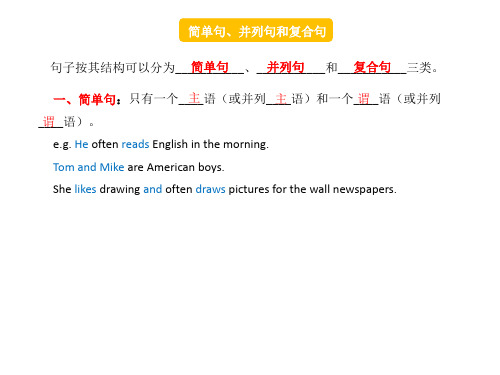

:七年级上册:Unit 1—Unit 9:侧重于陈述句和疑问句。
七年级下册:Unit 4:祈使句 Don't eat in the classroom.Unit 8:倒装句 There is a zoo in my neighborhood.Unit 2,Unit 3,Unit 5,Unit 9,Unit 11,Unit 12:特殊疑问句。
|八年级上册:Unit 7:There will be more people. There will be more pollution.Unit 8:First,peel the bananas. Next, put the bananas in the blender. Then, pour the milk into the blender. Finally, turn on the blender.八年级下册:Unit 3:For one week, she did not do any housework and neither did I.九年级:Unit 2 :What fun the Water Festival is! How fantastic the dragon boat teams were!"一、陈述句和疑问句1.陈述句用来陈述一个事实或表达说话者看法的句子叫“陈述句”,句末用句号表示句子的陈述结束。
陈述句分为肯定句和否定句。
(1)肯定句的基本结构:“主语+谓语+宾语”。
例如:I play basketball after school.(2)否定句又分为完全否定和部分否定。
①完全否定词有not,no,no one,nobody,nothing,neither,none,never。
例如:None of us have been to Canada.②部分否定词有hardly,seldom,few,little以及not与both,all,each,every,quite,always等连用所表示的部分否定。
例如:I can hardly see anything in the all students come to school by bus.*2.疑问句用来表示提问的句子叫作“疑问句”,句末用问号。
疑问句包括一般疑问句、特殊疑问句、选择疑问句和反意疑问句4种。
(1)一般疑问句①以系动词be开头的疑问句。
例如:Are you a student②以助动词开头的疑问句。
例如:Do you speak French③以情态动词开头的疑问句。
例如:Can you dance(2)特殊疑问句用特殊疑问词引导的疑问句叫“特殊疑问句”。
特殊疑问词包括疑问代词、疑问副词和由疑问词构成的疑问短语。
①常用疑问代词:what什么;who谁;whom谁(who的宾格);which哪个(些);whose谁的。
例如:What are you doing②常用疑问副词:when何时;where何地;how怎么;why为什么。
例如:Where are you going tomorrow③常用疑问短语:what time什么时刻;how many/much多少;how often多久一次;how soon多久;how long多长时间;how far多远;how old多大(年龄);how big多大。
例如:—How long have you been here—For 10 minutes.(3)选择疑问句用来在两种或两种以上情况中进行选择的疑问句叫作“选择疑问句”。
答语不能用Yes/No回答,而应从问句中选择一种情况进行回答。
①一般选择疑问句的构成:一般疑问句+or+被选择的内容例如:—Are you a teacher or a doctor—I'm a teacher.②特殊选择疑问句的构成:特殊疑问句+A or B例如:Which do you like better,tea or coffee(4)反意疑问句~附在陈述句后对陈述内容进行反问的句子叫“反意疑问句”,也叫“附加疑问句”。
反意疑问句前一部分是陈述句,后一部分是简短问句。
陈述部分用逗号结尾,疑问部分用问号结尾。
例如:It's a nice day,isn't it①疑问部分的主语必须与陈述部分的主语一致;当陈述部分的主语是名词或代词时,疑问部分要用相应的人称代词。
例如: comes from the UK,doesn't he②疑问部分要与陈述部分的时态保持一致。
例如:Tom went to the cinema yesterday,didn't he③答语是肯定的用“Yes”;答语是否定的用“No”。
前否后肯的反意疑问句的答语yes译为“不”,no译为“是的”。
例如:—Ann didn't come to school last week,did she—No,she didn' was ill.特别提醒反意疑问句的特殊形式①陈述部分是I am...,疑问部分用aren't I。
例如:I'm your best friend,aren't I②当陈述部分是there be结构时,疑问部分用there。
例如:There are many birdsin the tree,aren't there)③当陈述部分的主语是指示代词this,that时,疑问部分的主语用it;当陈述部分的主语是these或those时,疑问部分的主语用they。
例如:This is an English car,isn't it These are Russian planes,aren't they④当陈述部分含有never/nothing/none/no one/seldom/hardly/few/little等否定词时,疑问部分用肯定形式。
例如:She has never been abroad,has she⑤如果陈述部分含有由否定前缀im-,dis-,un-等构成的否定意义的词,则陈述部分作肯定处理,疑问部分仍用否定形式。
例如:Mary is unhappy,isn't she⑥当陈述部分的主语是不定代词something/anything/everything/nothing等时,疑问部分中代词用it。
例如:Nothing is wrong with the computer,is it⑦当陈述部分的主语为somebody/someone/anybody/anyone/everybody/everyone等时,疑问部分中代词用they或he,注意问句动词的数应与they/he保持一致。
例如:Everyone has known the news,hasn't he/haven't they⑧祈使句的反意疑问句a.祈使句是肯定形式,其反意疑问句中的疑问部分用will you或 won't you皆可。
例如:Be sure to write to us,will/won't youb.祈使句是否定形式,其反意疑问句中的疑问部分通常只用will you。
例如:Don't smoke in the meeting room,will you`c.以let开头的祈使句构成反意疑问句时, let's用shall we构成反意疑问句,其他均用will you。
例如:Let's take a walk after supper,shall we Let the boy go first,will you⑨当陈述部分是I think/I suppose/I believe/I consider等结构时,疑问部分一般与从句保持一致。
注意“否定前移”。
例如:I think you can do it better next time,can't you I don't believe there will be robots at people's homes,will there二、感叹句1.以what引导(1)What + a/an +adj.+单数可数名词 + 主语 + 谓语!例如:What a beautiful mountain it is!(2)What +adj.+可数名词复数 + 主语 + 谓语!例如:What great inventions he has made!(3)What +adj.+不可数名词 + 主语 + 谓语!例如:What bad weather it is today!:2.以how引导(1)How +adj. +a/an+可数名词单数+主语+谓语!例如:How clever a boy he is!(2)How +adj./adv.+主语+谓语!例如:How quickly Tom runs!三、祈使句祈使句表达说话人对对方的劝告、叮嘱、建议、请求或命令等。
主语you通常省略,谓语动词用原形,句末用感叹号或句号。
表达请求或劝告时,祈使句句末或句首可以加上please表示委婉的语气。
1.肯定祈使句(1)Do型:动词原形(+宾语)+其他成分。
例如:Please have a seat.(2)Be型:Be+表语(名词或形容词)+其他成分。
例如:Be quiet.~(3)Let型:Let+宾语+动词原形+其他成分。
例如:Let me help you.2.否定祈使句(1)Do型和Be型的否定式都是在句首加don't构成。
例如:Don't forget me! Don't be late for school!(2)Let型的否定式有两种:“Don't +let+宾语+动词原形+其他成分”和“Let+宾语+not+动词原形+其他成分”。
例如:Don't let him go./Let him not go.(3)有些可用no开头,用来表示禁止。
例如:No smoking!四、倒装句英语句子一般主语在前,谓语在后。
但有时因为语法结构的要求或为了表达特殊的强调部分,会把句中的谓语提到主语前面,这种句子叫“倒装句”。
倒装句的常见句式:be句型$(1)There be句型表示“存在”,主语在be的后面。
例如:There is some coffee in the cup.特别提醒there be与have的区别①There be结构表示“某地有某人/某物”,强调客观存在。
②have表示“(某人)拥有某物”,强调所属关系。